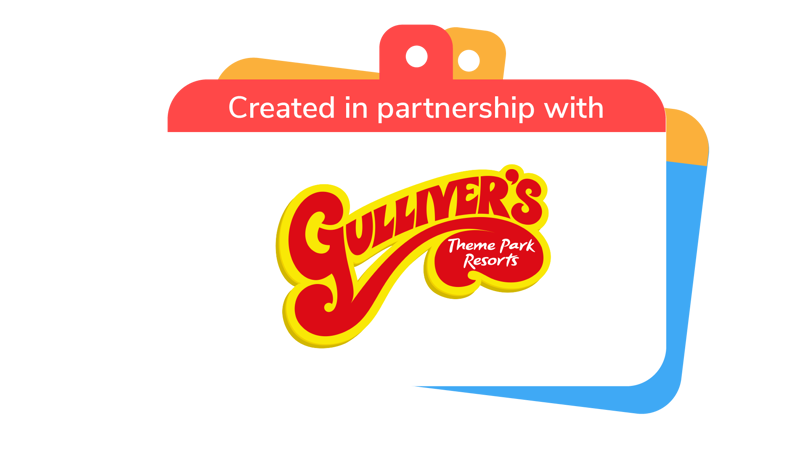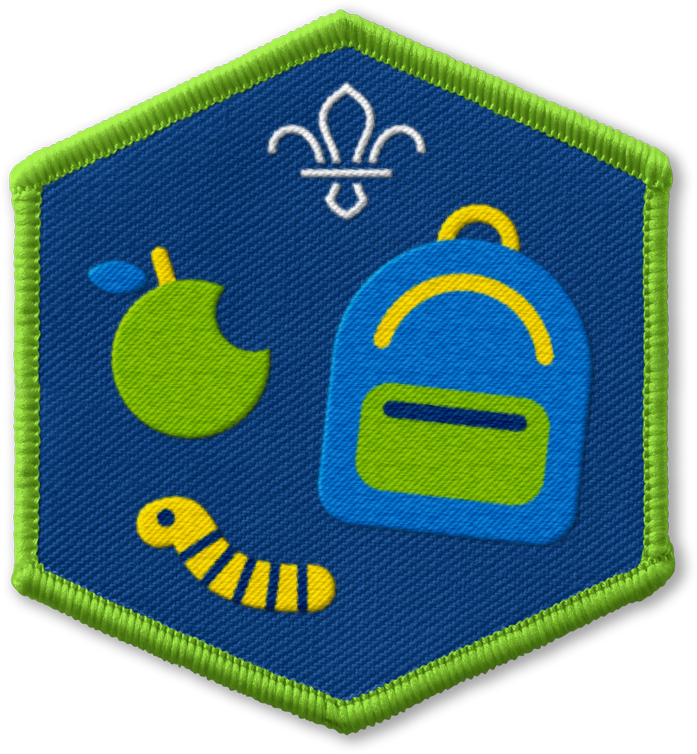
Try den building
You’ll need
- String
- Rope
- Blankets
- A4 paper
- Coloured pens or pencils
- Snacks
- Camera or phone
- Sticks
- Branches
- Bamboo canes
- Sheets
- Towels
- Tarpaulin
- Drinks
Try this at Gulliver's Theme Park Resorts!
Thinking of running this activity? Well, why not try it during a trip to Gulliver's Theme Park Resorts with your group. Whether you are there for a Scouts Takeover weekend, or heading out on a group visit with just your troop, this activity can be a great addition to your trip programming.
Learn more about the partnership hereBefore you begin
- Use the safety checklist to help you plan and risk assess your activity. Additional help to carry out your risk assessment, including examples can be found here. Don’t forget to make sure all young people and adults involved in the activity know how to take part safely.
- Make sure you’ll have enough adult helpers. You may need some parents and carers to help if you’re short on helpers.
Planning this activity
- Choose an appropriate outdoor area such as outside your meeting place, a nature reserve, woodland area, riverside, canal, or park. If you’re going to meet at a location other than at your usual meeting place, make sure parents and carers know exactly where you’ll be, what people may need to bring, the day, the location, and what time to drop off and collect everyone.
- Make sure everyone knows to come dressed for the weather. Don’t forget to check the forecast and be prepared for it to change.
- It’s important to check the sunset times, making sure that you’ll have sufficient light throughout the activity. It’s best to run this activity on lighter evenings, such as in summer.
- Remember to have suitable supervision, an InTouch process in place and activity consent forms. It’s important to make sure that anyone with medication, including an inhaler, brings it with them and gives it to a volunteer, too.
- Make sure the area you visit is accessible for everyone, choosing a suitable place for drop off and collection. You may need to think about avoiding steps or steep gradients or including frequent breaks.
- This activity could involve snacks and drinks. Remember to check for allergies, eating problems or dietary requirements and adjust the recipe as needed. Make sure you've checked everyone's dietary requirements and allergies then adapted the recipe as appropriate. This may include ensuring no cross-contamination during food storage, preparation and serving, too. Check if there are any items of food (or packaging) that people can’t touch or be near to or if there are items that people might not be comfortable using in the activity.
- Be conscious about who may be fasting when providing snacks, eating and drinking – you may want to plan this activity for when everyone can get involved or leave out the eating and drinking part.
Introducing the space
- Everyone should head out to the outdoor space or meet at the chosen venue.
- Explain the boundaries of the playing area and where the no-go zones are.
- You should quickly remind everyone of the countryside code in England and Wales, or the Outdoor Access Code for Scotland, or countryside code Northern Ireland.
- Tell people how they can use the space respectfully, without disturbing the wildlife or other people enjoying the site if you're in a public space. Remind people to be calm and quiet, so you don’t disturb wildlife, and not picking any flowers or plants. They should handle wildlife gently, take litter home to leave no trace, and put things back where they were found to make sure wildlife isn’t harmed or damaged. No one should take anything from a living plant and people should stay in sight of the adults who are supervising.
- Tell everyone where adults will be around the site and what people should do if anyone in their team needs help. This should include setting memorable spot where an adult will stay at all times.
- Explain the signal to stop play and how long the activity will go on for. A long blast on a whistle works well as a signal to stop the activity.
- If playing in a public space, young people should be paired up so no young person is left alone and they should run or move together.
Run this activity
- Everyone should collect materials to build dens, including branches, twigs, rocks, and other fallen materials. Remind everyone to be careful when lifting, carrying or moving any items. They should leave an item or ask for an adult to help if it’s heavy.
- If you're using this activity to achieve the Beaver Builder Activity Badge, make a list of all the materials you are going to use to create your den.
- Once everything has been collected, everyone should help take the materials to one outdoor place. It may be part of your meeting place, a local park or field, or even a school playground. It’s helpful if there are even more den building resources nearby such as fallen sticks, branches, or leaves.
- You can decide if you want to give people over items to help build a den, such as tarpaulin or rope.
Build a den
- Ask everyone to get into groups of about four or five people, and give each group an adult or young leader helper.
- Each group should talk about what sort of den they want. This is a great chance to get creative—maybe they’d like to build a knight’s castle, a dragon’s cave, an animal’s hideaway, or a team clubhouse. An adult or young leader can help everyone think about their ideas, making sure everyone has a say, but the groups should come up with the ideas and make the final decision.
- Tell everyone how far away they’re allowed to go—they should choose an area everyone must stay in, so everyone stays safe. Let each group choose a spot within the area to make a den, making sure every group has plenty of space.
- Each group should choose the materials they need from the selection they made earlier.
- Give everyone around 20 minutes to build their den. Each group’s helper should remind them to try things out to check whether their ideas are working or whether they could be improved. All responsible adults should be mindful of and check all of the dens for hazards, such as falling sticks. If anyone finishes early, they can move on to the next step.
- Each group should decide on a name for their den. They could design flags or decorations for their den—perhaps they could make a string of bunting or a flag complete with a bamboo cane flagpole to stick in the ground.
Enjoy your dens
- Each group should sit inside their den. If they’re having drinks and snacks, now would be a great time to enjoy them inside their creation.
- People can visit each other’s dens to look at their ideas. Everyone’s den will be a bit different, and that’s great. You might want to take a picture of each den, too. Make sure you have the correct photography permissions in place if you do.
- If you're using this activity to achieve the Beavers Builder Activity Badge, make sure everyone gets a chance to explain how long it took them to build their den, what might have gone wrong and what they would do differently if they were to build it again.
- At the end, everyone should carefully dismantle their dens, and spread the natural materials back out where they got them from. Although it’s a bit sad to take work apart, it’s important to leave nature as you found it so people can enjoy the space.
Reflection
This activity was a chance to be a team player. It was a little different to some other teamwork tasks as you had to decide on your own goal—it was up to you what your final den looked like. There weren’t really any rules, so you had to talk to each other and figure out what you were going to do.
Sit inside your den with your group. How did you all work together? You may want to think quietly, or talk to the others.
How did you decide what kind of den to make? What did you do to help your team? How different would this activity have been if you worked alone?
This activity also helped you to value the outdoors. Nature gives us lots of amazing resources and we can have lots of fun with them. It’s important that we respect nature.
How did you show you valued the outdoors when you gathered your materials? What about at the end of the activity—what did you do then, and why did you do it?
Safety
All activities must be safely managed. You must complete a thorough risk assessment and take appropriate steps to reduce risk. Use the safety checklist to help you plan and risk assess your activity. Always get approval for the activity, and have suitable supervision and an InTouch process.
- Outdoor activities
You must have permission to use the location. Always check the weather forecast, and inform parents and carers of any change in venue.
- Poles and long objects
Be careful when moving poles or long items. Take care if the ends are sharp. Have appropriate supervision for this activity.
- Gardening and nature
Everyone must wash their hands after the activity has finished. Wear gloves if needed. Explain how to safely use equipment and set clear boundaries so everyone knows what’s allowed.
Teams could use natural materials to make their dens cosy, for example, leaves could make comfy areas to sit, or sticks could make a shelf. Don’t forget that you should only use found materials—no one should pull branches, leaves, or flowers off a plant.
Everyone should have a job to do, whether they’re the designer, site manager, or a builder.
All Scout activities should be inclusive and accessible.
If you want to, you could check if the dens are waterproof. Make sure everyone is wearing a coat or something waterproof, such as a bin bag, so they stay warm and dry afterwards. Ask everyone to get in their dens and gently pour a bit of cold water over each den - did anyone get wet? Or did they stay nice and dry?
Each group should decide where and how they build their den, as long as they stay inside the area agreed with the adult volunteers.



